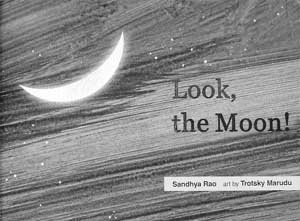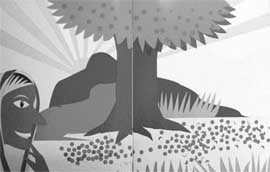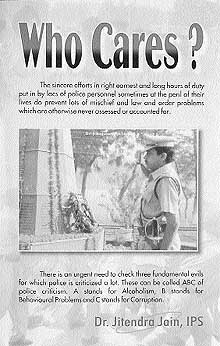|
Short takes
by Randeep Wadehra
Look, the Moon!
by Sandhya Rao. Tulika, Chennai. Rs. 70.
 Right
from infancy wonderment becomes a factor in one’s growing up process.
The many-splendoured nature — birds, animals, plants, snowcapped
mountains, flowing streams, germination of seeds — never ceases to
amaze children. Among all these the moon holds a special place. After
all chanda mama is part of our folklore. Right
from infancy wonderment becomes a factor in one’s growing up process.
The many-splendoured nature — birds, animals, plants, snowcapped
mountains, flowing streams, germination of seeds — never ceases to
amaze children. Among all these the moon holds a special place. After
all chanda mama is part of our folklore.
It glides across the
star spangled black canopy, spreading its milky-white sheen even as it
constantly changes its shape and size, playing hide and seek with
earthlings, at times using the clouds as a screen and then, impishly,
not appearing at all for a couple of days. This keeps kids enthralled.
This imaginatively
produced and eloquently illustrated lovely book is a must read for
growing children.
Kolaba
by Sandhya Rao. Tulika. Rs 80.
 Ah
for those bedtime tales that grandma used to narrate ever so softly and
vividly into our ears — taking us to a world peopled with dainty
fairies, gallant princes and lovely princesses and occasionally real
people and animals — all speaking a common language. We, as kids,
never questioned the tale’s premise that humans and animals could
actually converse with each other. We just listened to the tale, wide
eyed, punctuating it with appropriate exclamations. Fox has been a
fabled character — whether flattering a conceited crow into singing
and thus losing the piece of bread or cheese held in its beak, or
calling the grapes sour out of sheer frustration. Ah
for those bedtime tales that grandma used to narrate ever so softly and
vividly into our ears — taking us to a world peopled with dainty
fairies, gallant princes and lovely princesses and occasionally real
people and animals — all speaking a common language. We, as kids,
never questioned the tale’s premise that humans and animals could
actually converse with each other. We just listened to the tale, wide
eyed, punctuating it with appropriate exclamations. Fox has been a
fabled character — whether flattering a conceited crow into singing
and thus losing the piece of bread or cheese held in its beak, or
calling the grapes sour out of sheer frustration.
In this originally Marathi
story Kolaba, a greedy fox, is vying with Sonabai, a halwa-seller,
for the juicy red berries that grow in front of her house. Who wins the
battle of wits? Your kids will tell you if you gift this beautifully
worded and illustrated book to them. By the way, did you know that kolhaba
is Marathi for fox?
What plagues the police
Who Cares?
by Dr Jitendra Jain. S. Dinesh Sales Corp., Jalandhar. Pages 204. Rs 195.
 The
umpteen, albeit spasmodic, attempts to refurbish the not-so-bright image
of the Indian police have failed for various reasons. Chiefly, the
colonial mindset of the rulers and the ruled alike is to blame. Police
was an instrument of suppression in the hands of the British, which is
now being cynically used by free India’s politicians as quasi-feudal
militias to terrorise the common people into submission. There is not a
single state in India where the police is looked upon as people-friendly
— despite tall claims to the contrary. Worse, our police force is
getting increasingly criminalised. The
umpteen, albeit spasmodic, attempts to refurbish the not-so-bright image
of the Indian police have failed for various reasons. Chiefly, the
colonial mindset of the rulers and the ruled alike is to blame. Police
was an instrument of suppression in the hands of the British, which is
now being cynically used by free India’s politicians as quasi-feudal
militias to terrorise the common people into submission. There is not a
single state in India where the police is looked upon as people-friendly
— despite tall claims to the contrary. Worse, our police force is
getting increasingly criminalised.
Is politicisation of
the force the only reason for such a sorry state of affairs? The author
points out that since policemen are products of a society, their values
mirror the norms prevalent in the society. However, reforms in the
police force are long overdue.
This book takes a look at
the history of the police in India and the causes for its present
ailments, and suggests various remedies. Chapters like Corporate Cult in
Policing, Crime Analysis and New Horizons are worth a read. Jain has
also given enough space to public comments and the policemen’s
reactions thereto. At the end of the book there is a list of
abbreviations that should be of use to readers.
|